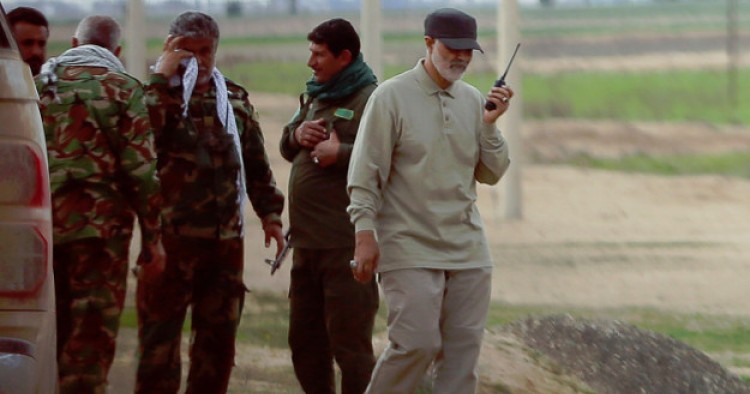Iranian-led Afghan Shiite militia forces have made significant territorial gains in southeastern Syria and have reached the shared border between Syria and Iraq, the Iranian media reports. “After extensive efforts, the Fatemiyoun forces and their allies in the resistance axis succeeded two days ago to overcome the obstacle of American air strikes and reach the Iraqi-Syrian border,” Tasnim News Agency, which is affiliated with the Islamic Revolution Guards Corps (I.R.G.C.), reported today. The news agency also published photographs of Iranian Quds Force Commander Qassem Soleimani celebrating the victory with the Afghan forces close to the shared border. But the I.R.G.C. outlet warned that a dangerous confrontation with the U.S. military and its allies is on the horizon. “A serious battle has now shaped up between America and groups it controls and the Syrian Army and its allies over who will dominate the border regions in southern Syria.” It further added by reaching the border, pro-Damascus forces will be able to cut off the supply lines of the Islamic State militants into Syria.
Comment: The Fatemiyoun was founded by leaders of two Afghan Shiite militant groups: Sepah-e Muhammad (Muhammad Army), an Iran-backed group that operated against the Taliban in Afghanistan in the 1990s, and the Abuzar Brigade, which fought alongside Iranian military forces against Iraq in the 1980s. According to Iranian military sources, more than 2,000 Afghans perished during the Iran-Iraq war in the 1980s. The founder of Fatemiyoun, Alireza Tavasoli, was a veteran of the Iran-Iraq war and was a close confidante of Soleimani; when Tavasoli was killed in Syria, Soleimani visited his family to pay tribute.
The Fatemiyoun is perhaps the largest Iranian-supported militia group fighting in Syria. The exact number of the Afghan militiamen is unknown, but an Iranian official earlier this year said 18,000 Afghans were fighting in Syria to support Damascus. In May 2015, Defa Press, an outlet affiliated with the General Staff of the Armed Forces of Iran, reported that the Fatemiyoun had been upgraded from a brigade to a military division due to its increasing size and operational capabilities.
Interviews with Fatemiyoun militants with the Afghan media demonstrate that the I.R.G.C. recruits destitute and undocumented Afghan refugees by offering them permanent residency, financial aid, and other incentives for their families. Others say they joined Iran’s war in Syria to escape prison sentences. Of some 2.5 million Afghans living in Iran, a third are registered as refugees while the remainder are mostly illegal economic migrants.
However, not all Afghan Shiites fight in Syria for money or legal status. Many also go to Syria for ideological, religious and political reasons. The profiles of senior Fatemiyoun commanders, for example, show that they are neither poor nor illegal migrants. Many are born in Iran, studied in religious seminaries in Qom, and have had long-standing ties with the I.R.G.C. and the Basij Force.
The increasing role of Afghan and Pakistani Shiites in defending the Assad regime comes at a time when their fellow Sunni countrymen are fighting on the opposing side in Syria – sparking fears that they will fuel sectarian tension in their respective countries once they return. “It is likely that Sunni and Shiite Afghans fighting in Syria and Yemen return someday and their sectarian grudges get them to fight each other at home,” warned Hasht-e Sobh.
Moreover, Iranian military leaders have indicated that Tehran would use the Fatemiyoun in other regional conflicts once the Syrian war is over - primarily against Israel.
The Middle East Institute (MEI) is an independent, non-partisan, non-for-profit, educational organization. It does not engage in advocacy and its scholars’ opinions are their own. MEI welcomes financial donations, but retains sole editorial control over its work and its publications reflect only the authors’ views. For a listing of MEI donors, please click here.












